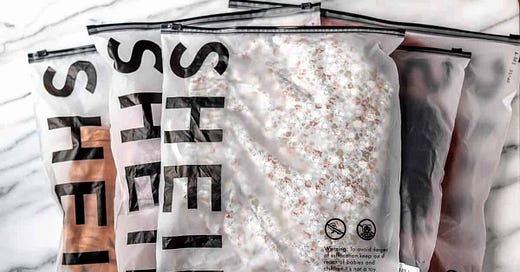SHEIN, Science Based Targets, and the Limits of Measurement
Voluntary accounting standards and corporate pledges will only take us so far; what we needed is cultural change, which starts with each of us.
Reductio ad absurdum is the form of argument that seeks to disprove a statement by taking it to its most extreme and absurd edge. Last week, the corporate sustainability community reached this edge with the news that SHEIN, which pioneered and scaled disposable fashion to $38 billion in sales last year (or more than H&M and Inditex/Zara combined), had its net-zero target approved by the Science Based Targets Initiative (SBTi).
SBTi is the most rigorous and widely accepted suite of voluntary corporate decarbonization standards in the world. More than 10,000 companies have a science based target or commitment, with 1,805 joining SHEIN in meeting the even higher bar required to set a net-zero target. To achieve net zero, a company must offset its total emissions by removing carbon from the atmosphere.
Before diving into the specifics on SHEIN, I want to make a few points:
Having a public emissions goal is better than not having one, as it both signals corporate intent and can serve as a leverage point for internal teams to justify investing in decarbonization.
Setting voluntary goals is much easier than achieving them. We’ve recently seen companies like Pepsi pulling back from their climate commitments with no real consequences.
Greenhouse gas emissions targets only look at emissions; they do not consider other types of impacts that a business can have on the planet (water, biodiversity, workers rights, etc.) The criticism of this in sustainability circles is called carbon tunnel vision.
We should all hope that SHEIN achieves its net zero goal AND that its disposable fashion business model falls out of favor, forcing the company to pivot.
To meet its net zero goal, SHEIN will have to decarbonize its products and the impact of transporting and distributing those goods to customers, which together account for 96% of its emissions, with the majority coming from products.
From a product perspective, SHEIN asserts that it will be “switching to and promoting greater usage of alternatives with lower carbon footprints, for instance, using recycled instead of virgin polyester – scaling textile-to-textile recycling will be an important part of the transition to recycled polyester.”
All of these actions will lower its carbon footprint, but there’s simply no path to a sustainable apparel industry built on disposable clothing–especially when 76% of SHEIN’s fiber is polyester, which comes from petroleum. Polyester has a lower carbon footprint than cotton, but that does not mean that it’s more sustainable or better for the planet; all it means is that we’ve gotten really efficient at converting oil into polyester.
Disposable, plastic clothing doesn’t disappear–it goes into the environment, where it pollutes, sheds microplastics, and disrupts natural systems (I recently wrote about plastic pollution here). Even more importantly, people who buy disposable garments need to buy LOTS of them, which will require more resources to make and cause more damage once they’re disposed of.
Constant consumption is what SHEIN wants and needs. Earlier this week, European regulators accused the company of breaking EU consumer laws through its use of fake discounts; pressure selling tactics such as false deal deadlines; misleading claims, often about product sustainability; deceptive labeling; and making it difficult for customers to contact the company.
Even a net zero carbon business built atop a wasteful business model that relies on fossil fuels cannot be sustainable. The approval of SHEIN’s net zero target exposes the limits of an approach to impact reduction that seeks to isolate a single metric (emissions) on a company-by-company basis without looking at the larger, systemic factors.
So what can you do to counteract the march towards disposable clothing? A lot, in fact. Here are three easy steps you can take to promote a more sustainable apparel industry:
Buy Better to Buy Less: A closet full of clothing that’s rarely worn is wasteful. When buying clothes, be intentional. Having fewer high quality items will make you look and feel better while lowering your carbon footprint. I’m quite bullish on the potential of regenerative organic farming practices, materials, and products. If possible, buy used versions of great products (most of my hiking gear is from Patagonia’s Worn Wear).
Trade-in Your Clothes When Possible, Donate When Not, Recycle as a Last Resort: The old clothes at the back of your closet likely still have wears in them. If the brand you bought from has a resale business, trade it back to the brand. Otherwise, consider donating them to Goodwill, which will resell or recycle what it can.
Staples can be Simple: No one wants to buy my used undershirt. For products that aren't likely to be resold, seek our single-material options like 100% cotton shirts that are easier to recycle than material blends.
Voluntary accounting standards can help shift corporate behavior in the right direction, but real change will require us to change our culture, which must begin with how each of us consumes.



